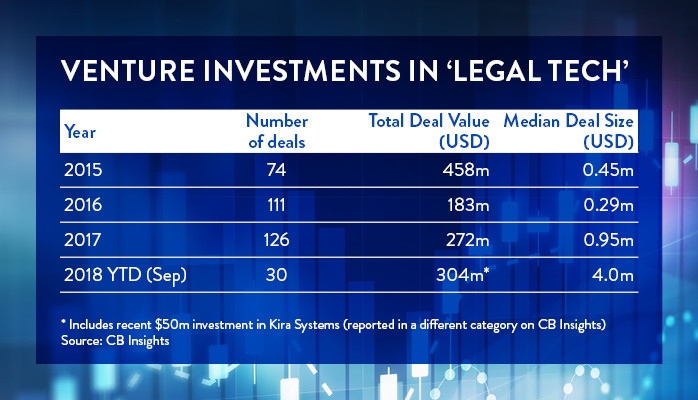
Why Investors Are Betting Big On Legal Tech
01/14/2019 By Bill4Time Staff

Work used to be all about labor.
If a problem needed to be solved most firms simply threw more hours at their challenges. It’s no surprise then that the results were often hit or miss.
That’s no longer the case.
Today there’s a significant demand for legal technology. Investors have caught wind of this trend and they’re rushing to meet (fund) the demand for legal tech.
Are investors really all that interested in law firms?
They’re not focused on firms.
They’re focused on legal tech. That’s the automatic assumption most readers make when they hear about the seismic shifts taking place in the legal profession. While most think “The investors are coming” attorneys ask “What about ABA model rule number 5.4?” As you know rule number 5.4 states (among other things):
“A lawyer shall not form a partnership with a non-lawyer if any of the activities of the partnership consist of the practice of law.”
Investors are focused technology that serves two distinct audiences.
- Consumers who are interested in highly effective, low cost legal technology to solve routine or mundane problems like declaring bankruptcy, drafting a will, etc.
- Law firms that are in desperate need of sophisticated tools. Resources that enable them to produce the highest quality work faster and in greater volume.
What’s driving demand?
Why are investors betting big on legal technology these days? There’s a simple, one-word answer that explains this demand in a nutshell.
Clients.
Clients have changed considerably over the last few decades. Firms have experienced a plethora of changes that developed slowly over time.
What sort of changes?
- Today, more and more clients are unwilling to pay for research costs
- More clients are unwilling to pay for first-year/junior associates
- Clients are demanding alternative fee arrangements
- Clients expect firms to go (far) above and beyond the simple delivery of legal services
- Clients are quick to ask questions, quick to say No.
- More clients are refusing to pay their invoices in full or on time
- Firm fees are climbing as realization rates are free falling
- Clients don’t want to be sold an idea, they want to be part of building it
This list isn’t comprehensive.
But it’s meant to convey some key points. The legal profession has been (erroneously) viewed as one filled with “fat cats.” Professionals preying on their client’s goodwill and profiting due to some hidden largesse. This is true in the vast minority of cases.
You know the truth.
If you’re like most attorneys, you work incredibly hard for the business you receive. The competition is cutthroat. It seems there’s always downward pressure on your fees – even as demand and performance requirements increase.
Investors see it.
Investors are betting big on their ability to fix the problem
Not directly of course but with their money.
Investors believe there’s an opportunity to invest their way to the solution.
Think about it for a second.
Leading venture capital firms made key investments in 2018.
| Legal technology investments: 2018 | |
| Logikcull ($25m) | CSDisco ($20m) |
| Everlaw ($25m) | LawGeex ($12m) |
| Seal Software ($30m) | Kira Systems ($50m) |
| LegalZoom ($500m) | Atrium LTS ($65m) |
Here’s where things get interesting.
The volume of the investment in 2018 exceeded the volume in 2017. Yet there were 76 percent fewer deals done in 2018. What does this mean?
Better quality deals.
Investors are choosing carefully. They’re focusing on high-quality deals that are much more likely to produce results.
Here take a look.

See the difference?
Here’s a more detailed breakdown of the investment landscape.
So what does this mean for attorneys? How does this affect law firms and the industry as a whole?
The majority of firms fail to innovate
Cue the eye rolls.
This sounds like a cute catchphrase doesn’t it? As if it’s a word that’s not grounded in the harsh reality you’re facing on a day-to-day basis.
It’s actually the opposite.
Here’s how Mark Cohen, legendary trial attorney and legal columnist at Forbes describes innovation.
“What is Innovation? It’s more than a catch-phrase. ‘Innovation’ has several meanings dependent upon context. “The introduction of something new” is the Merriam-Webster definition. In business, ‘innovation’ is applying ideas to satisfy the needs and expectations of customers. Innovation is the causal connection between/among idea, application, adoption, and result—satisfied customers. Innovation produces results that benefit clients.”
Remember the list of changes I mentioned earlier?
There’s a long list of changes that have taken place over the last few decades. Clients have been trying to tell professionals in our industry that they’re dissatisfied. That they’re unhappy with the solutions firms in the past have offered them.
Most firms haven’t listened.
This is why we’ve seen such a large investment in legal tech. Investors are injecting capital in an effort to solve the problems/meet the needs of two distinct groups.
- Consumers who are interested in highly effective, low cost legal technology to solve routine or mundane problems like declaring bankruptcy, drafting a will, etc.
- Law firms that are in desperate need of sophisticated tools. Resources that enable them to produce the highest quality work faster and in greater volume.
Here’s how this affects you.
You have a choice to make. It’s an opportunity actually. Clients in the marketplace want innovation. They’re looking for firms that can deliver new, creative solutions. A way to relieve the mounting pressure they’re facing from a variety of sources.
Clients today are dealing with:
- A more litigious environment that has become difficult to navigate
- New legal threats from a variety of sources
- An ever-growing web of complex laws, compliance requirements and expectations
- More pressure from outside forces in the form of competitors, predators and threats
- A dizzying array of data, details and procedures
The list goes on and on.
So here’s the crucial question. How can attorneys use this investor shift to benefit their firms?
- Give clients the innovative solutions they need to solve their laundry list of complex problems. Focus your attention on the advocacy and on billing for true value versus simply invoicing for time. Meet each of your clients four needs.
- Use emerging legal tech (i.e. practice management software) to create the leverage, value, outcomes and results your firm needs to grow. Instead of fighting legal tech, lean into it. Use software providers to grow your firm. Test low cost providers like LegalZoom. Create a map of their strengths and weaknesses.
You have an opportunity.
Most firms are trying to resist the change that’s already upon them. They’re trying to maintain the status quo, to maintain a traditional stance on how they practice law.
It’s not going to work.
Your clients are under pressure to change. Law firms (and the industry) are all under pressure to change. Investors are scrambling to meet the demand. Change isn’t coming, it’s already here.
Are you ready?
The law used to be all about labor
It used to be about your firm’s collective abilities, knowledge and expertise. If a problem needed to be solved most firms simply threw more hours at their challenges. The results were often hit or miss.
Not anymore.
Legal technology gives firms and clients the tools they need to solve complex problems efficiently. Investors have seen the opportunity. They’re investing their money in an attempt to meet the growing demand.
Are you?
If you haven’t moved to meet the demand there’s still time. You still have time to take advantage of the opportunity in front of you.
But you’ll need to act fast.
Your competitors are starting to act on this opportunity as well. The window of opportunity may close in time. There’s a significant demand for legal technology. With the right approach and technology as your ally, your firm will have the tools it needs to survive in any market.
But only if you start now.




